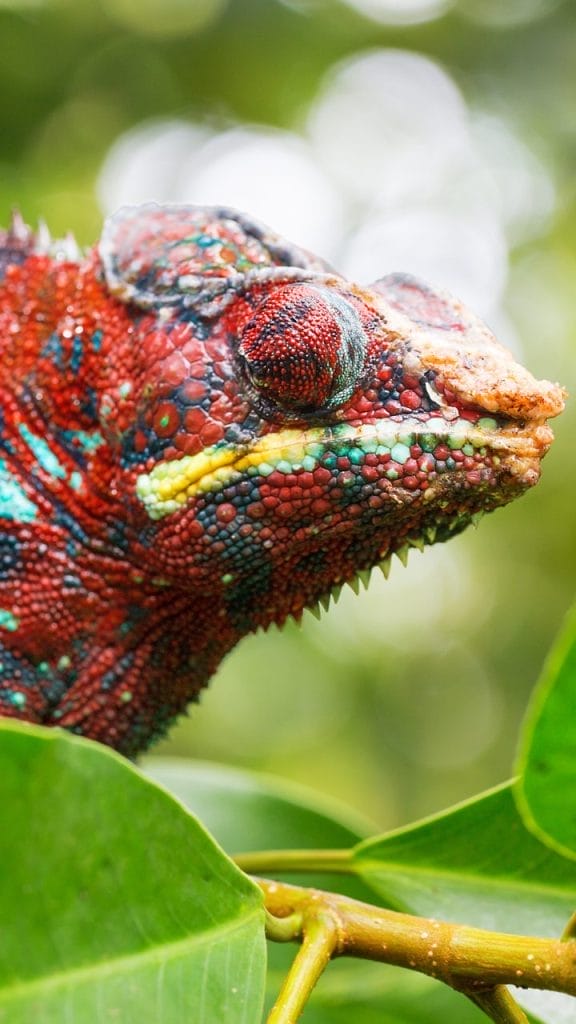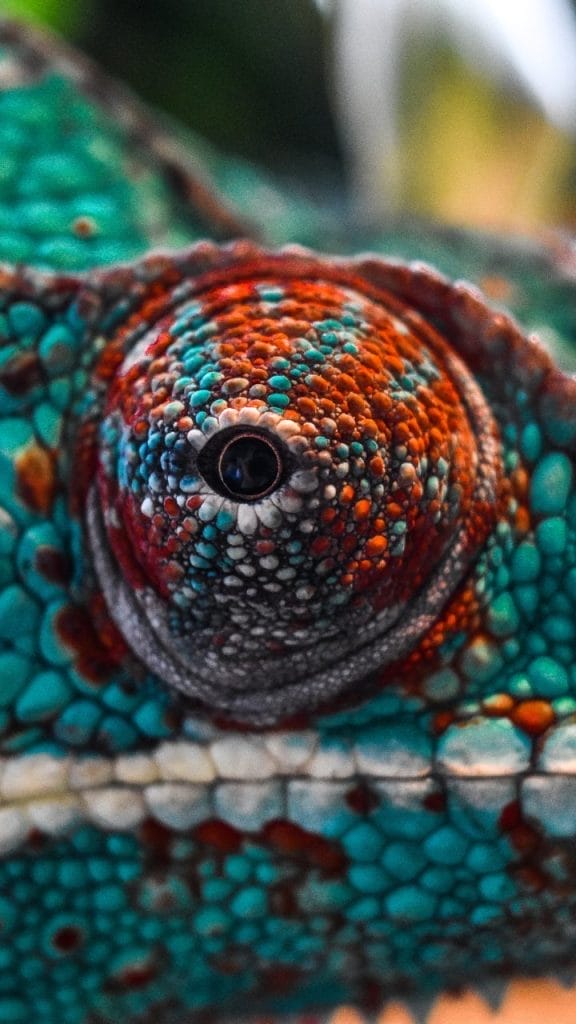This post was created with help from AI tools and carefully reviewed by a human (Muntaseer Rahman) . For more on how we use AI on this site, check out our Editorial Policy.
Check Out These FREE Tools We Made JUST For You!
Complete Panther Chameleon Care Guide: Everything You Need to Know (Before You Mess Up)

Look, I’m not going to sugarcoat this.
Panther chameleons are drop-dead gorgeous, basically living rainbows that can change colors and shoot their tongues like tiny reptilian superheroes.
But here’s the thing nobody tells you until it’s too late: these guys are NOT beginner-friendly.
I mean, if you’ve never kept a reptile before, a panther chameleon is like deciding your first car should be a Formula 1 racecar. Sure, it’s cool, but you’re probably going to crash spectacularly.
That said, if you’re ready to put in the work? They’re absolutely worth it.
Let me walk you through everything you need to know about keeping these incredible creatures alive and thriving.
What Exactly IS a Panther Chameleon?
Panther chameleons (Furcifer pardalis) are basically Madagascar’s gift to the reptile world.
They’re one of the largest chameleon species, with males hitting 12-20 inches long and females staying smaller at 10-14 inches.
But size isn’t what makes them famous. It’s the colors. Oh man, the colors.
Depending on where in Madagascar their ancestors came from (called “locales”), males can be bright red, electric blue, vivid green, orange, yellow, or even combinations that look like someone spilled a paint store on them.
Names like Nosy Be, Ambanja, and Ambilobe actually refer to specific locations in Madagascar, and each locale has its own distinctive color patterns.
Females, on the other hand, got the short end of the color stick. They’re usually tan, brown, or peachy-orange. When they’re carrying eggs, they turn dark black with orange stripes, which is nature’s way of saying “leave me alone.”
Males are bigger, flashier, and generally more dramatic about everything. Typical.
Quick Reference Care Sheet
| Care Aspect | Requirement |
|---|---|
| Enclosure Size | 24″x24″x48″ minimum (males), 18″x18″x36″ (females) |
| Temperature (Day) | Basking: 85-90°F, Ambient: 75-80°F |
| Temperature (Night) | 60-70°F, no lights |
| Humidity (Day) | 40-60% |
| Humidity (Night) | 75-100% |
| UVB | T5 HO 5.0 or 6%, 12 hours on/off |
| Diet | Varied insects, gut-loaded |
| Supplements | Calcium (daily), D3 + multivitamin (2x/month) |
| Lifespan | 5-7 years (males), 2-3 years (females) |
| Handling | Minimal, display animal |
| Housing | ONE chameleon per enclosure |
The Real Talk: Are Panther Chameleons Good Pets?
Here’s where I need to be brutally honest with you.
Panther chameleons are sensitive and require lots of specialized equipment. They’re not the kind of pet you can wing.
Males live 5-7 years with proper care, sometimes even 8-9 years if you’re doing everything right. Females only live 2-3 years, mainly because egg-laying takes a massive toll on their bodies.
In the wild, they only live a few years due to predators, parasites, and disease. Captive breeding has made these guys way hardier than they used to be, but they’re still not forgiving if you mess up their care.
Think of them as display pets. They’re elegant animals you watch rather than handle regularly. If you want a lizard to carry around on your shoulder, get a bearded dragon.

Setting Up the Perfect Panther Chameleon Enclosure
Alright, this is where most people screw up, so pay attention.
Enclosure Size: Bigger is ALWAYS Better
Minimum enclosure size for an adult male: 24″L x 24″W x 48″H (that’s 2x2x4 feet).
Ideally, you want 36″L x 24″D x 48″H if you’re building your own or have the space. Males get big and cramped cages stress them out.
Females can manage with slightly smaller enclosures at 16″L x 16″W x 30″H, but again, bigger is better.
For babies, start with something smaller like an 18″x18″x36″ cage so they can actually find their food. Use this for the first six months, then upgrade.
Height matters way more than floor space because these guys are arboreal. They live in trees. The floor is basically lava to them.
Screen vs. Glass: The Great Debate
Here’s where it gets interesting.
Everyone says chameleons MUST be in all-screen cages, but that’s not completely true. It depends on where you live.
Live in a dry climate? Glass, wood, or PVC enclosures work better because they hold humidity.
Live somewhere humid? Screen cages with 2-3 solid sides work great. The solid sides increase the chameleon’s sense of security and reduce stress.
Southern California? Screen cages outdoors and hybrid cages indoors work perfectly.
The key is good airflow. Stagnant air leads to respiratory infections, which can kill your chameleon.

Decorating the Cage (AKA Making It Not Suck)
Your chameleon needs branches, vines, and plants. Lots of them.
Live plants like Pothos, Ficus Benjamina, and Schefflera are perfect. They help with humidity, give your chameleon hiding spots, and make the cage look less like a prison.
Use slightly springy wooden perches and reptile vines so their feet can stretch and rest. Thin branches are better than thick ones for gripping.
Think jungle canopy, not empty cage with one stick.
Substrate: Keep It Simple (Or Skip It)
Most keepers don’t use substrate at all – bare bottom makes cleaning easier and gives feeder insects nowhere to hide.
If you insist on substrate, use paper towels or newspaper.
For bioactive setups, use coco soil or a nutrient-rich soil mix with a drainage layer underneath. But honestly? That’s advanced stuff. Start simple.
Female chameleons need a laying bin even if they’ve never met a male. Use a 12-inch deep container with washed play sand and/or organic soil. They’ll lay infertile eggs and need somewhere to do it.

Temperature & Lighting: Don’t Mess This Up
This is critical. Get this wrong and your chameleon dies. Not kidding.
Basking Temperatures
For adults:
- Basking spot: Mid-80s°F (around 85-90°F)
- Ambient temperature: Mid to high 70s°F (75-80°F)
- Nighttime: 60s°F is perfectly fine
For juveniles:
- Basking spot: 85-90°F
- Ambient: Around 75°F
Create a temperature gradient – hot at the top (95°F), cooler at the bottom (around 71°F).
Use a digital thermometer and temperature gun to monitor this stuff. Those analog thermometers from pet stores are garbage.
No heat at night. Night lights mess with their sleep patterns. If your house gets cold, use a ceramic heat emitter, NOT a colored bulb.
UVB Lighting (Non-Negotiable)
UVB lighting helps chameleons synthesize vitamin D3, which they need to absorb calcium. Without it, they get Metabolic Bone Disease and die horribly.
Use a T5 HO ReptiSun 5.0 or Arcadia 6% UVB bulb, running 12 hours on, 12 hours off.
If your basking spot is 12-15 inches from the light, use a 6% bulb. If it’s 15-24 inches away, use a 12% bulb.
Also, you need a separate bright 6500K LED or fluorescent lamp because UVB bulbs alone aren’t bright enough. Bright light is important for their mental health.
Replace UVB bulbs every 6-12 months even if they still turn on. The UVB output decreases over time.
Humidity: The Goldilocks Zone
This is where chameleons are weirdly specific.
Day humidity: 40-60%
Night humidity: 75-100%
Yeah, they like it DRY during the day and WET at night. Opposite of what you’d think.
How to Achieve This
Daytime: Mist 2-3 times lightly. Just enough to create dew on leaves.
Nighttime: Use a cool mist humidifier or fogger for a few hours before “sunrise”.
Always use distilled water in humidifiers to prevent equipment clogging and bacterial growth. Clean your misting system weekly.
Chameleons don’t drink from bowls – they lick water droplets off leaves. So misting isn’t just for humidity, it’s how they hydrate.
Add a dripper system that drips throughout the day. You can buy one or DIY it with a container and a small hole.
Use a digital hygrometer to monitor humidity. Again, those analog ones are useless.

Feeding Your Panther Chameleon: The Bug Buffet
Variety is the key to a healthy chameleon. They’re insectivores, meaning they eat bugs. Lots of bugs.
What to Feed
Staple feeders (daily food):
- Crickets, dubia roaches, silkworms, black soldier fly larvae
Treats (occasionally):
- Hornworms, superworms, waxworms (in moderation)
Baby panthers need 7-10 crickets daily. Adults eat 3-5 large insects every other day.
Never feed wild-caught insects. They might have pesticides or parasites.
Gut-Loading is Non-Negotiable
Feed your feeder insects nutritious food 24-48 hours before offering them to your chameleon.
Why? Because your chameleon is eating what the bugs ate. Garbage in, garbage out.
Use commercial gut-load products or fresh veggies and greens.
Supplements (The Secret Sauce)
This is where people get confused, so here’s the simple version:
Calcium without D3: Daily, with every feeding
Calcium with D3: 2 times per month
Multivitamin: 2 times per month
Lightly dust your insects before feeding. Don’t coat them like powdered donuts.
Chameleons are extra sensitive to calcium and vitamins – mess this up and they get Metabolic Bone Disease.
Special Notes for Females
Once females hit maturity (around 6-7 months), cut back feeding to 4-5 insects only 2-3 times a week.
Why? Overfeeding females leads to massive egg clutches, which causes reproductive issues and shortens their lifespan.
Also, keep female basking temps at 80°F instead of 85-90°F to help control clutch size.

Common Health Problems (And How to Avoid Them)
Let me tell you about the things that can go wrong, because knowledge is power.
Metabolic Bone Disease (MBD): The Silent Killer
MBD is caused by lack of calcium, improper supplementation, or inadequate UVB lighting.
Symptoms include:
- Bow-legged appearance, problems climbing or walking
- Crooked jaw or curved spine
- Shortened casque (the head crest), swollen limbs
By the time you see symptoms, the damage is often irreversible. This is why proper UVB and calcium supplementation are NON-NEGOTIABLE.
Caught early, mild MBD can be treated with improved diet, supplements, and proper UVB exposure. Severe cases need vet intervention with injectable calcium.
Prevention is simple: follow the care guidelines above.
Dehydration
Signs include sunken eyes, lethargy, and loss of appetite.
Fix it by increasing misting frequency and duration. Make sure water droplets are collecting on leaves.
Respiratory Infections
Poor ventilation and high humidity combined cause respiratory infections.
Symptoms include wheezing, lethargy, and excess mucus.
This is why good airflow is critical. Screen or hybrid cages > glass tanks.
Parasites
Common in wild-caught chameleons but less common in captive-bred.
Regular vet check-ups with fecal tests catch these early.
Thermal Burns
Happens when heat lamps are inside the cage or too close to basking spots.
Always place heat sources outside and above the cage, and use guards if needed.

Handling Your Panther Chameleon: Less is More
Real talk? Chameleons are solitary and easily stressed by frequent handling.
They’re not puppies. They tolerate handling at best.
After bringing your chameleon home, leave it alone for 1-2 weeks to settle in.
When you do handle them:
- Approach slowly from below (hands from above look like predators)
- Let them walk onto your hand, don’t grab them
- Never pull them off a branch – carefully unwind their tail and feet
Some panthers are more docile than others, and many associate their owners with food after a while.
But minimize handling. Stress kills chameleons.
Cost Breakdown: What You’re Actually Spending
Let’s talk money because nobody warns you about this part.
Initial Costs
| Item | Price Range |
|---|---|
| Panther chameleon | $100-$300 |
| Screen/hybrid enclosure (24x24x48) | $100-$200 |
| UVB lighting kit | $50-$100 |
| Basking lamp & fixture | $20-$40 |
| Thermometers/hygrometers | $20-$40 |
| Misting system/fogger | $30-$150 |
| Plants & decorations | $50-$100 |
| Timer | $10-$20 |
Total setup cost: Roughly $500-$1,000
Monthly Costs
- Feeder insects: $30-$50
- Supplements: $10-$15
- Electricity: $10-$20
- Replacement plants: $10-$20
Total monthly: $60-$100
Annual Vet Costs
Expect $75 per check-up, and fecal tests plus treatment can run up to $150.
Healthcare is unpredictable, but budget at least $200-$300 annually.
Over a chameleon’s lifetime, you might spend 50 times the purchase price.

Beginner Mistakes to Avoid
Let me save you some pain by listing what NOT to do:
1. Housing multiple chameleons together – They’re territorial and solitary. One chameleon per cage, period.
2. Using glass aquariums – Poor ventilation = respiratory infections.
3. Handling too much – Stress kills. They’re not dogs.
4. Skipping UVB or supplements – MBD is a death sentence.
5. Using tap water in misters – Clogs equipment and isn’t good for plants or chameleons.
6. Buying wild-caught specimens – They’re usually sick, stressed, and have shorter lifespans. Always buy captive-bred.
7. Keeping females on a male feeding schedule – Overfeeding = health problems.
8. Using colored night bulbs – They disrupt sleep patterns.
The Bottom Line: Should You Get a Panther Chameleon?
Look, I’m not going to lie to you.
Panther chameleons are high-maintenance, expensive, and unforgiving if you mess up.
But if you’re willing to do the research, invest in proper equipment, and commit to their care? They’re absolutely incredible.
These living rainbows are mesmerizing pets that reward dedication with years of fascinating behavior.
Just don’t impulse-buy one because they look cool. That’s how chameleons end up sick or dead.
Do your homework. Set up the enclosure BEFORE you buy the chameleon. Join online forums like Chameleon Forums and learn from experienced keepers.
And for the love of everything scaly, follow the care guidelines in this article.
Your future rainbow friend is counting on you.
About Author
Hello, I’m Muntaseer Rahman, the owner of AcuarioPets.com. I’m passionate about aquarium pets like shrimps, snails, crabs, and crayfish. I’ve created this website to share my expertise and help you provide better care for these amazing pets.
Disclaimer
This site is owned and operated by Muntaseer Rahman. AcuarioPets.com is a participant in the Amazon Services LLC Associates Program, an affiliate advertising program designed to provide a means for sites to earn advertising fees by advertising and linking to Amazon.com. This site also participates in other affiliate programs and is compensated for referring traffic and business to these companies.

